The name’s the same – but a lot has changed since Ford last sold a Ranger pick-up in the United States.
For openers, the new Ranger is mid-sized; the old Ranger (last sold in the U.S. in 2011) was a much smaller truck.
A compact-sized truck.
Power – and capability have been increased, too.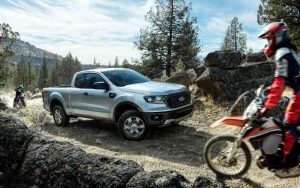
The new Ranger comes standard with a 270 horsepower turbocharged engine – and can pull as much as 7,500 lbs. – which makes it more powerful (and capable) than some full-size trucks used to be as well as all of its current mid-sized rivals are – including some of them equipped with their optional engines (with one asterisk; more follows below).
On the downside, you can’t get it with less than four doors – even if you only want two. And even though it’s much larger than the old Ranger, it doesn’t come with a bigger bed.
As almost always – pros and cons.
The new Ranger is a mid-sized truck, similar in general layout to others in this class like the Chevy Colorado (and its GMC twin, the Canyon) the Nissan Frontier and the Toyota Tacoma.
Like them – like all the currently available mid-sized pick-ups – there’s no regular cab/long bed version available, which limits what you can put in the bed.
But because the Ranger has much more engine than its compact-sized forbear, it can pull thousands of pounds more behind its bed.
And because it has more cab, it can also carry more people – and much more comfortably.
Prices start at $24,300 for a base trim 2WD XL Supercab (two full-size front doors, two smaller, rearward-opening rear doors) with a six-foot bed and run to $38,385 for a loaded 4WD Lariat Crew cab ( four full-size doors) and five-foot bed.
All trims – even the base XL – come standard with the same 270 hp 2.3 liter turbocharged engine and a ten-speed automatic transmission.
This gives the Ford an edge (couldn’t resist) over its rivals, none of which come standard with comparably powerful engines.
However, some of the Ranger’s rivals – including the Colorado/Canyon – cost several thousand less to buy than the Ford. The GM twins are also available with both a stronger gas V6 engine (3.6 liters, 308 hp) and a diesel engine – as well as a manual transmission (with the base 2.5 liter liter engine).
On the other hand, the Toyota Tacoma – another rival – costs several thousand more to start ($25,850) and its standard engine (2.7 liters) is much weaker (159 hp) than the Ford’s.
The Ranger is new . . . to the United States.
Ford has been selling it everywhere else for several years.
What’s Good
Strong standard engine – strong standard towing capacity.
Mid-sized cab is much roomier than previous compact-sized cab.
Bed is much more accessible than current full-size truck beds.
What’s Not So Good
No engine – or transmission – options.
Crew cab comes only with the short (five foot) bed.
Almost as long as full-size trucks once were, but not as functional as a full-sized truck.
Trucks usually give you a range of drivetrain options to choose from. Ford decided to make it easier for you to choose by equipping every Ranger with the same drivetrain – leaving you to concentrate on trims and cabs and beds.
The standard 2.3 liter engine makes 270 horsepower and 310 ft.-lbs. of torque. It’s similar to the 2.3 liter engine used in the Mustang, but not the same engine.
First, the specs are different. The Mustang’s version of the 2.3 engine makes 310 horsepower and 350 ft.-lbs. of torque.
Interestingly, the Ranger’s version of the 2.3 liter engine has a slightly a higher compression ratio (10.0:1) than the Mustang’s version (9.5:1), so the Mustang 2.3’s higher rated output must be due to higher boost.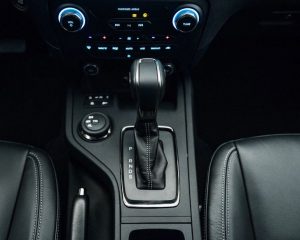
Either way, the Ranger’s engine offers much more of both horsepower and torque than summoned by any of the Ranger’s rivals’ standard engines – none of which benefit from a turbocharged goosing.
It’s also why the Ranger has the mightiest standard tow rating in the class – 7,500 lbs. – which is also more than the others can tow, period – even with their optionally available engines.
With an asterisk.
The GMC twins can pull slightly more (7,700 lbs.) when ordered with the turbodiesel engine you can get in both of them. That engine makes a mighty 369 ft.-lbs. of torque – close to V8 torque – and the most torque you can get in a mid-sized truck. But Chevy and GMC only sell the diesel in the high-trim versions of the Colorado and Canyon; these cost $10,000 more than the cost of the entry-level XL Ranger . . . before you add the diesel – which adds another several thousand dollars.
How much is that extra 200 lbs. of tow capacity worth to you?
Regardless of trim, you can go 2WD or 4WD, the latter with a two-speed transfer case and 4WD Low range gearing.
Ground clearance ranges from the base 2WD XL’s 8.4 inches to 8.9 inches for 4WD-equipped models.
The standard 10-speed automatic has three overdrive gears (8th, 9th and 10th) with 10th being a super deep .63 ratio, which enables the truck to cruise at 70 with the engine turning just over 2,000 RPM.
This accounts for the new Ranger’s better-than-the-old Ranger gas mileage – even with 3.73 gears in the pumpkin.
The 2WD version rates 21 city, 26 highway; the 4WD version 20 city, 24 highway.
The old Ranger with the 4.0 liter V6 – and just 207 hp – rated 16 city, 23 highway.
It also didn’t get to 60 in just over six seconds.
The new Ranger does.
The new Ranger drives a lot like a ’90s-era F-150. This is a compliment.
It’s big, but not too big.
It’s hunky, but not cod-pieced WWF steroidal, as current half-tons have arguably become.
A big man doesn’t feel small. You can touch the bed floor without standing on a milk crate – and get in the bed without a ladder.
And the truck doesn’t feel small if you are a big man.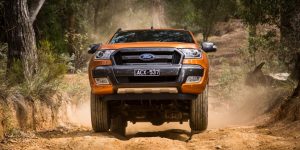
It’s also not too wide – relative to the road – as the current F-150 (and other current half-ton trucks) sometimes feel like they are. The Ranger’s relative svelteness – it’s 85.5 inches at its widest point – is especially valuable in the era of Lane Keep Assist – and steering wheel shake – the “assist” that generally comes with Lane Keep Assist. Which gets triggered like a social justice warrior who just saw a MAGA hat whenever one of the vehicle’s tires touches the double yellow to your left or the white line to your right.
Because there’s too much truck in between.
Instead of a quivering lip and stomping foot, a steering wheel that shakes like you just lost some vital front end component.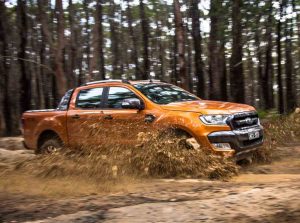
And when your vehicle is so wide that you almost can’t help regularly treading on one of those painted lines, the steering wheel is almost constantly shaking.
Which is annoying – as well as distracting. Especially when you can’t turn the Lane Keep Assist off – which is the case in a number of new vehicles.
It’s not a problem here.
The new Ranger is also like the old Ranger – and older half-ton trucks – in that it is a remarkably mechanical truck. It hasn’t got manual-lock hubs – but it does have a manual pull-up emergency brake on the center console rather than a push-button electric parking brake. This gives you more control when the Ranger is moving – rather than merely securing it when you’re finished parking.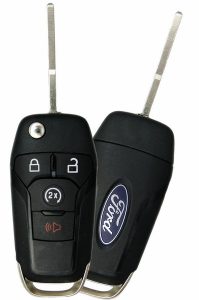
There’s a mechanical (engine/belt-driven) mechanical fan, too. This may cost a few horsepower vs. electric fans, but mechanical is simpler and that usually ends up meaning more reliable, especially long term.
And more easily fixable in the field – as opposed to at the dealership.
It also comes standard with a manual locking tailgate – and a physical/mechanical ignition key. If you drop it in the river, you won’t have to call for a tow. And you can get a new key cut – which is a lot cheaper than buying a new fob.
The main gauge cluster is analog – needles and dials – and to the point.
You can call up useful, driving-related info such as angle of inclination and declination on the accessory LCD screen in between the main gauges – but there’s not so much info that you lose yourself in it.
And the Ranger’s relatively simple – mostly analog – cluster is likely to last longer and be a lot cheaper to replace if it ever stops working.
The new Ranger also drives very differently than the old Ranger – a compliment, again.
It feels much more substantial – especially on unpaved roads. The extra weight keeps the leaf-sprung/live-axle rear from bouncing excessively. But the main differentiator is that the reimagined Ranger has power to spare; more power than a ’90s-era Mustang GT Cobra – and is nearly as quick, even though it weighs hundreds of pounds more.
The old Ranger had its virtues, but speed was never among them. Now it is.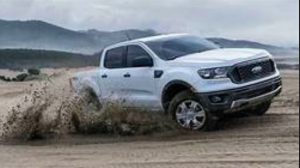
Another virtue of the new Ranger relative to two of its three same-sized rivals is its much tighter turning circle: 41.9 feet vs. 44.1 feet for the Tacoma and 43.6 feet for the Frontier. Both of these two are fairly ancient trucks – the Nissan dating back to 2004, when it was upsized and the last time it was appreciably updated.
The GM twins have the tightest turning circle – though (again) it’s not by much: 41.3 feet.
The optional FX4 off-road package ups the Ranger’s ground clearance to nearly 9 inches and includes an additional Terrain Management program for the 4WD system, as well as a 4WD Low crawl mode and underbody skid plates, M/S-rated tires and special trim.
It’s a vey capable of-roader, arguably more so than current half-tons with similar equipment but which are wide-bodied that negotiating narrow trails with trees on either side is almost a people of WalMart situation.
Regardless of cab/bed configuration, the Ranger is the same overall length – 210.8 inches.
The old Ranger (regular cab/six-foot bed) was just 189 inches long overall – so not much longer overall than a typical mid-sized car. It had the virtue of being as easy to park as a mid-sized car.
The new Ranger is just as long – almost literally on the nose – as a 1990 Ford F-150, a full-size truck (back in 1990). It was 210 inches long – for the regular cab version.
Which you can’t get in a Ranger anymore.
Or any other mid-sized truck.
This truck – and all the other trucks in the class – only comes with a short (and shorter) bed. The Super cab gets a six-foot bed, which is short in relation to the rest of this upsized truck.
If you go with the Crew cab and four full-size doors, you have to accept the shorter 5.1 foot bed – which is the only way this one comes.
Which means that while it can carry more people – and pull a lot more – than the old Ranger, the new Ranger can’t carry more in its bed. And if you get the Crew cab, it carries less.
So why not offer a regular cab – or an eight foot bed?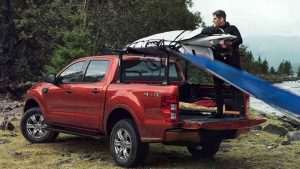
Probably because that would undercut current full-sized trucks like the F-150, which are available with both of those things . . . for a lot more money. If people could get those things for less money in a Ranger-sized package, many probably would.
So the Ranger is oriented more toward being a recreational people-carrier than a carrier of sheets of 4×8 drywall.
Which it does quite well.
The crew cab has 34.5 inches of backseat legroom – more backseat legroom, it turns out, than the much larger overall F-150 Super cab (which has 33.5 inches).
While the Ranger’s standard drivetrain is the strongest standard drivetrain in the segment, it’s also the most complex – turbo’d, intercooled and direct-injected; with a ten speed automatic bolted behind it – which may not be a virtue at some point down the road.
The not-turbo’d engines in rivals like the Frontier, Tacoma and GM twins may not have the balls – but will never hit their owners with a huge bill for a new turbo or intercooler.
And their transmissions – especially the Frontier’s and Tacomas – are older, proven designs with four fewer gears and so fewer moving parts and so less to potentially go awry at some point down the road.
Not that it will – but it might.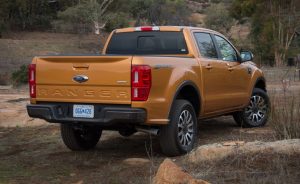
ASS – automated stop/start – is also (unfortunately) standard. As are Forward Collision Assist and Automated Emergency Braking, even in the base XL – both of them arguably a tag-team of electronic idiot-proofing and incremental/get-them-used-to-it-piecemeal automated driving tech.
Three or four years ago, this e-Nannying/Big Brothering was found mostly in higher end cars and so mostly avoidable. It is becoming standard – and so unavoidable – even in the lower-trim versions of bread-and-butter vehicles like the Ranger.
They can, at least, be turned off.
For now.
The Bottom Line
It’s nice to see the Ranger back on the roster – especially with more engine than most of its rivals. And much more to come. There is a Raptor version of the Ranger on the way.
If Ford were to endow it with more bed, it would be even nicer.
…
Got a question about cars – or anything else? Click on the “ask Eric” link and send ’em in!
If you like what you’ve found here please consider supporting EPautos.
We depend on you to keep the wheels turning!
Our donate button is here.
If you prefer not to use PayPal, our mailing address is:
EPautos
721 Hummingbird Lane SE
Copper Hill, VA 24079
PS: Get an EPautos magnet (pictured below) in return for a $20 or more one-time donation or a $10 or more monthly recurring donation. (Please be sure to tell us you want a sticker – and also, provide an address, so we know where to mail the thing!)
My latest eBook is also available for your favorite price – free! Click here. 




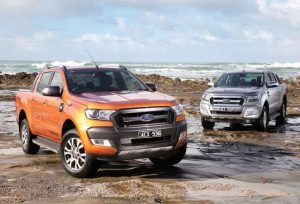
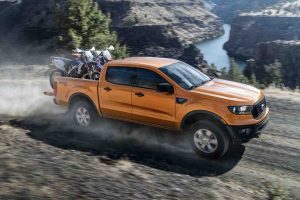
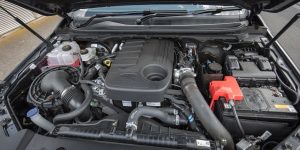
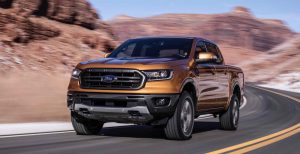
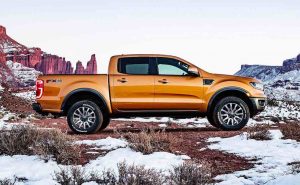









I as an owner of a 2004 Ford Ranger XLT SuperCab 4×4 like the new Ranger. I just have yet to see any on the road where I live. I think its taking a while for them to start hitting the streets. I like how the new truck is conservative in its appearance. I’d be going for an XLT trim personally if I had the cash. But dang, these new trucks are expensive. If you shop around, you can get a better deal on an F-150 with more bells and whistles versus the crazy typical $40k price tag on the new Ranger.
I’ll wait until they put a non-turbo V6 in the line-up.
Hi Hoth,
I wish they would but doubt they will… not unless the Orange Man rescinds the fatwa…
eric, I’m not too hot on a lot of things the orange one has already done. He just appointed a raging anti-gunner to be head of the, what should be non-existent, ATF. Let’s see, what has he done he promised in his campaign? Still thinking.
Hi Hoth,
It’ll be a long wait…unfortunately. I’m with you. Much as I mostly like this truck, the turbo four would give me the willies, post-warranty. It’s probably fine for the guy who drives it for 5-8 eight years from new. But I’m the kind of guy who wants 15-plus out of a vehicle…
eric, the GM 4 for trucks was built specifically for that purpose. It has all sorts of features that are simply great……as long as the myriad sensors hold up. Of course that’s the downfall of many good engine designs these days. If the independently tested 24.2mpg holds up and the engine holds up it will be great for those who don’t actually use a pickup. Then again, it performed in a uphill high altitude trailer pulling test as well as the 6.2.
But I’ll let you buy the 4 and make sure it’s ok. I’ll keep looking for a ’94 and older Turbo Diesel.
Re: Tow ratings
The GM twins with the diesel rate 7700# in 2wd.
The Gladiator has the highest 4wd tow rating in class at 7650#, with a Sport model with max tow package (automatic trans). A Rubicon tops out at 7000#.
The Ranger is 7500# for either 2wd or 4wd.
Another butt ugly, nightmare under the hood.
Though, it probably has more HP now than my 2013 V8 silverado which is only listed as 310HP but real whp 270-290
eric, let’s see….. .063 final ratio with a 10 speed. That’s a whopping .04 more than the 700 R4 and only 6 more gears. This 10 speed transmission bs is simply that. Notice REAL pickups that are very possibly going to be worked(I know, this is a dirty word these days) don’t have 10 speed transmissions.
The one time I drove a Chrysler 200 I put the read-out on the dash into showing the gear it was in. It almost never got past 7th at 70 mph. I couldn’t get it into 10th to save my life, even by letting completely off the accelerator. I finally ran it up to 85 and when I dropped off a steep hill I let off completely and watched till it finally showed 10th gear. By this time it was nearly to the bottom of the hill so a couple seconds later when I put my foot back into it since it was only going maybe 60 or so, it immediately went to 5th. Boy, are those ever useful transmissions….if you get off on watching a digital read-out while you should be watching the road.
I got to test-drive one at the local auto show last year before they went on sale, and I liked it a lot. Good power, the 10-speed auto didn’t gear-hunt that I noticed. No mention from Ford of a contractor-trim level with rubber floor liners, but the 4-door cab could work in favor of that, as you’d have room to pick up your day labor for the drive to the job.
Looks like the aftermarket is starting to design stuff like ladder racks, tool chests, and bed caps.
This Ranger is a good looking brute. Very “acceptable” amount of power. I like the mechanical (not digital) trim. A Real Truck should offer a longer bed option. But the six footer meets most of my needs.
I could see buying a Ranger, and think I’d probably like it. Nevertheless, if I really were shopping in this segment, I’d buy a Tacoma, to get the assured quality, reliability, and long term durability.
I do credit ford for building a nicer ranger. But the price of a well equipped 4×4 is very close to a full size F150 in a XL/STX 4×4. That factor by itself is going to suppress new ranger sales. So far to date I’ve only seen one new ranger on the road in my area since it was released for sale. A lot of friends I know like the new ranger. But as far as buying one, a majority prefer the F150 new or a couple of years old used to get more bang for the buck. I foresee Ford not selling as many new Rangers because of price.
Hi Allen,
This is what killed the Dakota, which was very unique at the time. It was available with a V-8, a manual (at least for awhile), a 6 1/2 foot bed with an extended cab and a reasonable overall size. But, it came to cost nearly as much as a full size Ram, which made it unappealing to many people. I have a 2002 Dakota that I love and plan to keep until such vehicles are outlawed.
Cheers,
Jeremy
I saw a new loaded Ranger at the dealership today… it was very nice, but had a sticker price of almost forty thousand bucks. Back in my day, son, you bought a Cadillac for less than that. Speaking of which, the Ranger WAS basically like a Cadillac — a/c, moonroof, leather seats, automatic, power door locks, power windows, etc. etc. — the works. You’d feel bad if you threw a bale of hay in it and got seeds all over the place or got a nickel-sized dent in it — not something you’d use for actual WORK like a 1975 F100 with a vinyl bench seat, metal dash and AM radio as an option.
Meh… not for this hilbilly.
As I said, the new Ranger has totally gotten away from the SPIRIT of the original…